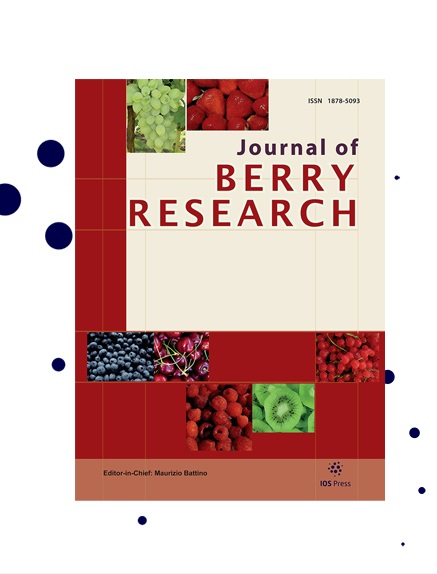不同成熟度和贮藏温度对独角莲采后贮藏品质的影响
IF 1.4
4区 农林科学
Q3 PLANT SCIENCES
引用次数: 0
摘要
背景:Pitanga (Eugenia uniflora L.)是一种南美浆果,具有甜味,富含生物活性化合物和抗氧化剂。然而,它的高含水量和含糖量,易变质和挫伤限制了它的保质期。目的:研究皮坦加在贮藏过程中的理化变化,确定最佳采收时间和贮藏条件。方法:Pitangas在成熟中期或完全成熟阶段收获,在2°C, 10°C或20°C下储存,并使用动力学方法分析物理和化学品质属性。结果:皮坦加贮藏温度对皮坦加失重、果损腐率、果硬度、总可溶性固形物含量、色泽变化等品质性状的动力学均有显著影响。然而,采收期间的成熟期仅影响少数品质属性的初始值。除维生素C外,pitanga的生物活性化合物含量和抗氧化能力不受贮藏温度和成熟阶段的显著影响。结论:pitanga在2℃条件下可保存20 d,比目前采后处理的pitanga保质期延长4倍。这一发现为优化皮坦加采后技术,从而提高其利用率和促进可持续生产实践提供了有价值的见解。本文章由计算机程序翻译,如有差异,请以英文原文为准。
Quality attributes of Pitanga (Eugenia uniflora L.) during postharvest storage as affected by ripening stage and storage temperature
BACKGROUND: Pitanga (Eugenia uniflora L.) is a South American berry with a sweet flavor and is rich in bioactive compounds and antioxidants. However, its high water and sugar content, susceptibility to spoilage, and bruising limit its shelf life. OBJECTIVE: This study aimed to investigate the physical and chemical changes of pitanga during storage and to identify the optimal harvest time and storage conditions. METHODS: Pitangas were harvested at mid or full-ripeness stages, stored at 2°C, 10°C, or 20°C, and analyzed for physical and chemical quality attributes using a kinetic approach. RESULTS: The storage temperature of pitanga significantly affected the kinetics of various quality attributes, including weight loss, percentage of damaged and decayed fruit, fruit hardness, total soluble solid content, and color change. However, the ripening stage during harvest only influenced the initial values of a few quality attributes. The bioactive compound content and antioxidant capacity of pitanga were not significantly affected by either storage temperature or ripening stage, except for vitamin C. CONCLUSIONS: Pitanga can be preserved at 2°C for 20 days, resulting in a four-fold increase in shelf life compared to current postharvest practices. This finding offers valuable insights into optimizing the postharvest technology of pitanga, thereby increasing its utilization and promoting sustainable production practices.
求助全文
通过发布文献求助,成功后即可免费获取论文全文。
去求助
来源期刊

Journal of Berry Research
Biochemistry, Genetics and Molecular Biology-Biochemistry
CiteScore
3.50
自引率
11.80%
发文量
21
期刊介绍:
The main objective of the Journal of Berry Research is to improve the knowledge about quality and production of berries to benefit health of the consumers and maintain profitable production using sustainable systems. The objective will be achieved by focusing on four main areas of research and development:
From genetics to variety evaluation
Nursery production systems and plant quality control
Plant physiology, biochemistry and molecular biology, as well as cultural management
Health for the consumer: components and factors affecting berries'' nutritional value
Specifically, the journal will cover berries (strawberry, raspberry, blackberry, blueberry, cranberry currants, etc.), as well as grapes and small soft fruit in general (e.g., kiwi fruit). It will publish research results covering all areas of plant breeding, including plant genetics, genomics, functional genomics, proteomics and metabolomics, plant physiology, plant pathology and plant development, as well as results dealing with the chemistry and biochemistry of bioactive compounds contained in such fruits and their possible role in human health. Contributions detailing possible pharmacological, medical or therapeutic use or dietary significance will be welcomed in addition to studies regarding biosafety issues of genetically modified plants.
 求助内容:
求助内容: 应助结果提醒方式:
应助结果提醒方式:


